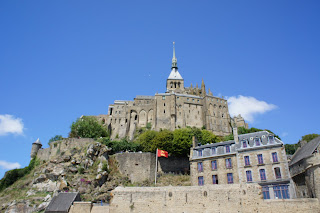It has certainly been an exciting week! The students spent the week gearing up for our two-day excursion in Brittany and Normandy, which took place over Thursday and Friday. In order to help visualize our latest voyage in France, I've traced our path using Google Maps, as seen in the image below:

Brittany is the larger peninsula to the west, and Normandy is the smaller peninsula to the north.
We took off from Saumur at 7:30 a.m. on Thursday morning in order to get to our first destination, Saint-Malo, for lunch. Saint-Malo, labeled as point B on the map, is a fortified port city on the coast of Brittany where students were able to eat a picnic prepared by their host families and explore the walled city. We had a great view of the sea, and took the opportunity for another beautiful group photo!

From there, we headed to Mont Saint-Michel, a small but rocky tidal island that houses the large Norman Benedictine Abbey of St Michel. Construction of the monastery began in the 8th

century, with additions continuing into the 20th century. Its rich history has placed it in the UNESCO list of World Heritage Sites and has made it a very popular tourist destination. After climbing quite a few steps to the top of the hill, we took a tour of the abbey, which lead through the large church and the monastic chambers, as well as a couple of crypts. The students appeared to have a great time studying the architecture and taking photos, and some of them could have spent several more hours there, but we had to take off on our last drive for the day to our hostel in Lion-sur-Mer (D on the map above). This small town in the department of Calvados is on the coast of Normandy, just north of Caen, a key target in the Battle of Normandy during World War II. The beach of Lion-sur-Mer makes up part of Sword Beach, one of the landing sites of the British troops in Operation Overlord on D-Day.

Upon arrival, we were presented with a very nice dinner consisting of chicken with a mushroom sauce (or ravioli for our vegetarians), a potato-cauliflower gratin, melon, bread, cheese, and dessert. After dinner, though it was already around 8 p.m., there was still plenty of daylight (the sun sets quite late here in the summer, around 10:30 p.m.), so we took the opportunity to have some fun on the beach. Despite being rather north (about the same latitude as the U.S./Canada border), we had a fairly warm day, and the water was actually quite warm and very calm. Several students swam in the sea, some for the first time, while others relaxed or played games on the beach. It was a great bonding time for the group, and gave everyone the positive energy we needed to tackle our second day of the excursion.
We woke up bright and early on day two and headed to our next destination, Caen (E above), which has a fantastic museum and war memorial called the Memorial for Peace. It includes expositions that cover events leading up to the war, during, and after, up through the Cold War. We saw a majority of the exhibits, covering themes such as the failure of peace, occupation,

resistance, the Holocaust, and D-Day. We then saw a film made of archived footage of the events of D-Day, with the perspective of the Allies on the left playing simultaneously with the perspective of the German forces on the right. The overall experience of the museum was incredibly informative and emotionally charged. The students had already discussed some of the events of the war in class the days prior to the excursion, but the museum gave us all a profound and meaningful visual representation to reinforce the ideas.
Our final destination was a visit to Omaha Beach and the Normandy American Cemetery and Memorial (F above). The cemetery, first established in 1944, is located in Colleville-sur-Mer and overlooks Omaha Beach, a famous landing site for American troops on D-Day.

The cemetery contains the graves of over 9,000 American soldiers, a memorial including the names of lost or unidentified soldiers and a statue called "Spirit of American Youth", and a small chapel. Students were given the time to visit the cemetery and then to walk down to Omaha Beach. I really can't speak for the students here – they have their own stories and impressions to share with you now – but the combined visit of the beach and the cemetery seemed to be the moment where the lesson of our intersecting histories and their consequences sank in the most. The students seemed quiet and pensive, but stayed in good spirits as always. By the end of the afternoon, they were ready to head back to the bus for our return to Saumur.

Kelly,
ReplyDeleteThanks for the poignant descriptions. We look forward to your blog each week. You make us feel close to our son and allow us to be part of his travel experience. We are grateful. Jim & Gretchen Van Duyn